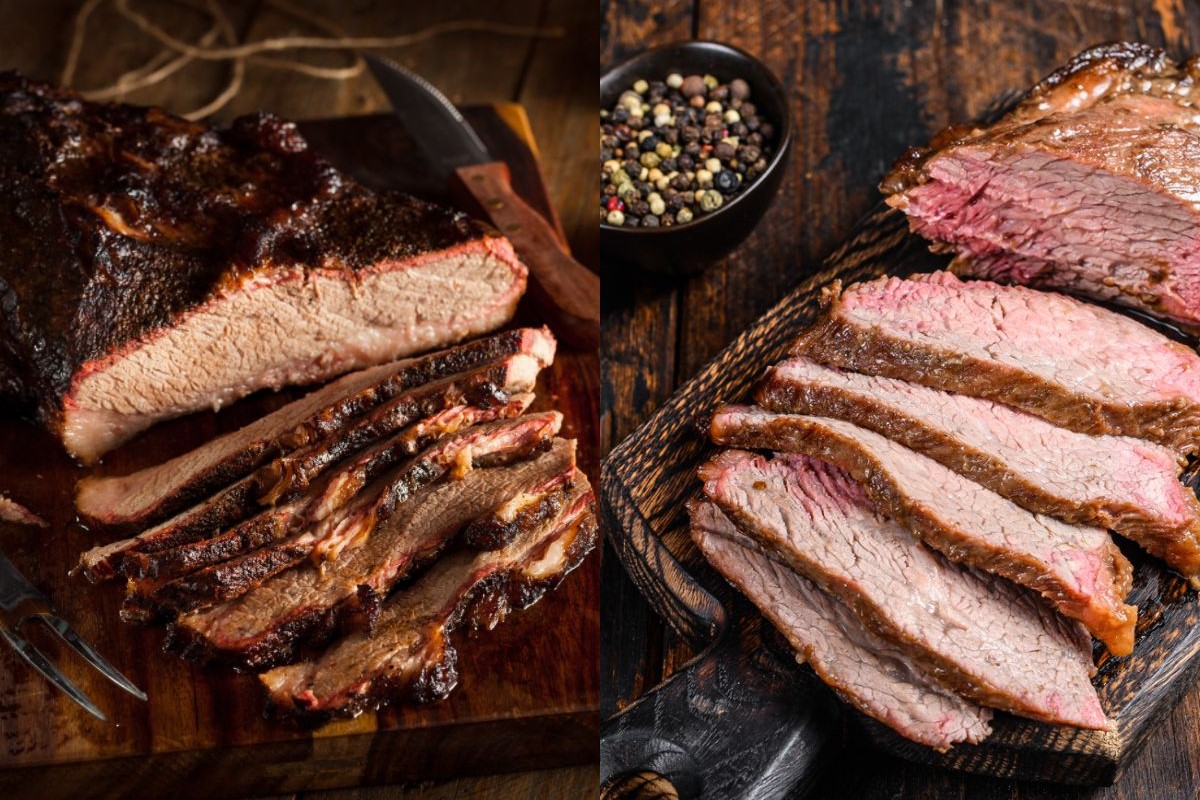Home>Food and Cooking>The Surprising Truth: Tri-Tip Vs Brisket – What You Need To Know


Food and Cooking
The Surprising Truth: Tri-Tip Vs Brisket – What You Need To Know
Published: February 11, 2024
Discover the differences between tri-tip and brisket in this comprehensive guide. Learn which cut is best for your next cooking adventure. Explore the world of food and cooking with expert insights.
(Many of the links in this article redirect to a specific reviewed product. Your purchase of these products through affiliate links helps to generate commission for Noodls.com, at no extra cost. Learn more)
Table of Contents
Introduction
When it comes to grilling or smoking meat, the choices seem endless. From tender ribs to succulent steaks, the world of barbecue offers a plethora of options to tantalize the taste buds. Among the many cuts of meat available, two popular choices that often spark debates among food enthusiasts are tri-tip and brisket. These cuts have their own unique characteristics, flavors, and cooking methods, making them stand out in the realm of barbecue.
As you embark on your culinary journey, understanding the differences between tri-tip and brisket is essential for creating mouthwatering dishes that will impress your family and friends. Whether you're a seasoned pitmaster or a novice griller, knowing the nuances of these cuts will elevate your cooking game and help you make informed decisions at the butcher's counter.
In this comprehensive guide, we will delve into the surprising truth behind tri-tip and brisket, exploring their individual traits, flavor profiles, cooking methods, and more. By the end of this article, you'll have a deeper understanding of these two beloved cuts, empowering you to make the best choice for your next barbecue extravaganza. So, let's fire up the grill and embark on a flavorful exploration of tri-tip and brisket!
What is Tri-Tip?
Tri-tip, also known as the bottom sirloin roast, is a triangular cut of beef that comes from the bottom sirloin primal cut. This flavorful and versatile cut gained popularity in the Central Coast of California before spreading to other regions. Its unique triangular shape and marbling make it a favorite among grillmasters and barbecue enthusiasts.
The tri-tip is renowned for its rich, beefy flavor and tender texture. When properly cooked, it boasts a perfect balance of juiciness and tenderness, making it a delightful choice for a wide range of culinary applications. Whether grilled, smoked, or roasted, the tri-tip offers a delectable eating experience that appeals to meat lovers of all kinds.
One of the defining features of tri-tip is its pronounced grain, which runs through the meat. This characteristic makes it crucial to slice the cooked tri-tip against the grain to ensure maximum tenderness. When prepared and sliced correctly, tri-tip yields succulent, melt-in-your-mouth slices that are sure to impress even the most discerning palates.
In addition to its exceptional flavor and texture, tri-tip is prized for its versatility. It can be seasoned and cooked in various ways, allowing for a myriad of flavor profiles to be infused into the meat. Whether marinated with zesty herbs and spices or simply seasoned with salt and pepper, tri-tip adapts well to different culinary styles, making it a beloved choice for home cooks and professional chefs alike.
When it comes to cooking methods, tri-tip shines on the grill. Its ample marbling and robust flavor respond well to high-heat grilling, resulting in a beautifully seared exterior and a juicy, medium-rare interior. Furthermore, tri-tip can be smoked low and slow to achieve a tender, smoky flavor that permeates the meat, adding depth to its already rich taste.
In essence, tri-tip is a versatile, flavorful, and beloved cut of beef that continues to captivate the palates of meat enthusiasts around the world. Its unique characteristics and culinary adaptability make it a standout choice for those seeking a memorable dining experience. Whether served as a standalone dish or incorporated into various recipes, tri-tip remains a cherished staple in the realm of barbecue and culinary exploration.
What is Brisket?
Brisket, a quintessential cut in the world of barbecue, is a flavorful and versatile beef cut that has earned a revered status among pitmasters and food enthusiasts. Derived from the lower chest of the cow, brisket is renowned for its rich, beefy flavor and distinctive texture. This cut is composed of two distinct muscles—the flat and the point—that contribute to its unique characteristics and culinary appeal.
The flat, also known as the "first cut," is a leaner portion of the brisket, featuring a fine grain and minimal fat content. In contrast, the point, or "second cut," boasts more marbling and connective tissue, rendering it exceptionally tender and succulent when cooked properly. This duality of textures within a single cut allows for a diverse range of cooking methods and flavor profiles, making brisket a beloved choice for creating mouthwatering dishes.
When it comes to flavor, brisket offers a robust and beefy taste that develops into a delectable richness when slow-cooked. Its ample marbling and connective tissue make it an ideal candidate for low and slow cooking methods, such as smoking or braising, which allow the meat to tenderize and develop complex, savory flavors. Whether seasoned with a dry rub or bathed in a flavorful marinade, brisket readily absorbs the aromatic elements, resulting in a deeply satisfying dining experience.
One of the most revered qualities of brisket is its ability to transform into a melt-in-your-mouth delicacy when cooked with patience and precision. The slow, gentle application of heat breaks down the collagen and connective tissues within the meat, resulting in a tender, moist texture that is synonymous with well-prepared brisket. This process yields succulent slices of meat that effortlessly pull apart, offering a truly indulgent dining experience.
Brisket's versatility extends beyond traditional barbecue methods, as it can be prepared in various ways to suit different culinary preferences. Whether smoked to perfection, braised in a savory sauce, or roasted with aromatic herbs, brisket adapts to a myriad of cooking techniques, allowing for endless creativity in the kitchen. Its ability to absorb and harmonize with a wide range of flavors makes it a canvas for culinary exploration, inspiring chefs and home cooks to experiment with diverse seasonings and cooking styles.
In essence, brisket stands as a testament to the artistry of slow cooking and the depth of flavor that can be achieved through patience and skill. Its rich, beefy taste, coupled with its tender, succulent texture, makes it a cherished centerpiece of barbecue gatherings and culinary feasts. Whether enjoyed as a standalone dish or incorporated into various recipes, brisket continues to captivate the palates of food enthusiasts, earning its well-deserved status as a beloved and iconic cut of beef.
Flavor and Texture Differences
The flavor and texture differences between tri-tip and brisket are distinct and play a pivotal role in defining the culinary experiences they offer. Understanding these nuances is essential for making informed choices when selecting and preparing these cuts of beef.
Tri-tip, with its triangular shape and ample marbling, boasts a rich, beefy flavor that is complemented by a tender and juicy texture. When cooked to perfection, tri-tip yields succulent slices with a balanced combination of tenderness and robust beef flavor. The pronounced grain of the meat adds a delightful texture, further enhancing the overall dining experience. Whether grilled, smoked, or roasted, tri-tip maintains its signature tenderness and juiciness, making it a versatile and flavorful option for various culinary applications.
On the other hand, brisket offers a robust and deeply savory flavor that develops into a rich, indulgent taste when slow-cooked. The flat, or "first cut," presents a leaner texture with a fine grain, while the point, or "second cut," features abundant marbling and connective tissue, resulting in a tender and succulent texture. This duality of textures within a single cut allows for a diverse range of culinary possibilities, from tender slices of lean brisket to melt-in-your-mouth, unctuous morsels from the point.
The differences in flavor and texture between tri-tip and brisket are further accentuated by their response to various cooking methods. Tri-tip excels on the grill, where high heat brings out its natural juiciness and creates a beautifully seared exterior. Its tender texture and robust flavor make it a delightful choice for grilling enthusiasts seeking a satisfying and flavorful dining experience. In contrast, brisket shines through slow cooking methods, such as smoking or braising, which allow the meat to tenderize and develop complex, savory flavors. The prolonged cooking process transforms brisket into a tender, moist delicacy that captivates the palate with its rich, indulgent taste and luxurious texture.
In essence, the flavor and texture differences between tri-tip and brisket offer unique and captivating culinary experiences. Whether savoring the succulent tenderness of tri-tip or indulging in the rich, savory depths of slow-cooked brisket, both cuts present distinct characteristics that cater to a wide range of culinary preferences and occasions. Understanding these differences empowers cooks and food enthusiasts to select the perfect cut for their desired dining experience, ensuring that every meal is a memorable and flavorful affair.
Cooking Methods
Cooking methods play a pivotal role in bringing out the best in tri-tip and brisket, allowing their unique flavors and textures to shine through. Understanding the most suitable techniques for each cut is essential for achieving exceptional results and creating memorable dining experiences.
Tri-Tip
Tri-tip is exceptionally well-suited for grilling, thanks to its ample marbling and robust flavor. The high heat of the grill sears the exterior of the tri-tip, locking in its natural juices and creating a caramelized crust that adds depth to its flavor profile. Whether seasoned with a simple blend of salt and pepper or marinated in a flavorful concoction, tri-tip responds well to the direct heat of the grill, resulting in a beautifully seared exterior and a juicy, medium-rare interior.
In addition to grilling, tri-tip can also be smoked to perfection, infusing it with a delightful smoky flavor that permeates the meat. The low and slow smoking process allows the rich, beefy taste of the tri-tip to harmonize with the aromatic essence of the wood, creating a multi-layered flavor profile that captivates the palate. When smoked to tender perfection, tri-tip yields succulent slices that boast a tantalizing smokiness, offering a unique and memorable dining experience.
Brisket
Brisket, with its rich marbling and dual textures, is best suited for slow cooking methods that allow it to tenderize and develop complex, savory flavors. Smoking, a beloved technique for preparing brisket, involves the gentle application of low heat and aromatic wood smoke, resulting in a tender, moist texture and a deeply satisfying dining experience. The prolonged smoking process breaks down the collagen and connective tissues within the brisket, transforming it into a succulent delicacy that effortlessly pulls apart, offering a truly indulgent dining experience.
Braising is another popular method for cooking brisket, where the meat is gently simmered in a flavorful liquid until it reaches a melt-in-your-mouth tenderness. This slow, gentle cooking process allows the brisket to absorb the savory essence of the braising liquid, resulting in a rich and deeply satisfying dish that is sure to impress.
In essence, the cooking methods for tri-tip and brisket are tailored to bring out the best in each cut, allowing their unique characteristics to shine through. Whether grilling tri-tip to juicy perfection or slow-cooking brisket to tender, succulent perfection, the chosen techniques play a crucial role in creating unforgettable dining experiences that celebrate the rich flavors and textures of these beloved cuts of beef.
Cost and Availability
When it comes to cost and availability, tri-tip and brisket present distinct considerations for consumers and culinary enthusiasts. Understanding the pricing and accessibility of these cuts is essential for making informed decisions and planning culinary endeavors.
Tri-tip, with its growing popularity and versatility, is readily available in many regions, particularly in areas where it has gained a strong culinary following. This availability is reflected in its relatively moderate pricing, making it an attractive option for those seeking a flavorful and budget-friendly cut of beef. Whether sourced from local butchers, specialty meat markets, or major supermarkets, tri-tip is often accessible year-round, allowing consumers to incorporate it into their culinary repertoire with ease.
In contrast, brisket, while widely celebrated in the realm of barbecue and culinary traditions, may present different considerations in terms of cost and availability. Due to its larger size and the specific demand for certain cuts within the brisket, such as the point or flat, the pricing and availability of brisket can vary based on factors such as region, market demand, and seasonal fluctuations. While brisket is commonly found in butcher shops, specialty meat markets, and select supermarkets, its pricing may reflect the labor-intensive preparation and slow cooking methods associated with this revered cut.
Furthermore, the availability of brisket may be influenced by cultural and regional preferences, as it holds a significant place in various culinary traditions and barbecue cultures. This can impact its accessibility in certain areas, with brisket being more prevalent and competitively priced in regions where it is a staple of local cuisine or culinary practices.
In summary, the cost and availability of tri-tip and brisket offer distinct considerations for consumers and culinary enthusiasts. While tri-tip presents a moderate pricing and widespread availability, brisket may vary in cost and accessibility based on factors such as regional demand, cultural significance, and market dynamics. Understanding these nuances empowers individuals to make informed choices when selecting these cuts for their culinary endeavors, ensuring that they can enjoy the unique flavors and culinary experiences that tri-tip and brisket have to offer.
Which One Should You Choose?
When it comes to choosing between tri-tip and brisket, several factors come into play, each contributing to a unique culinary experience. Understanding the distinct characteristics and culinary applications of these cuts is essential for making an informed decision that aligns with your preferences and cooking style.
If you're seeking a versatile and flavorful cut that lends itself well to various cooking methods, tri-tip may be the ideal choice for your culinary endeavors. Its triangular shape, ample marbling, and rich beefy flavor make it a standout option for grilling enthusiasts and home cooks looking to create succulent, tender dishes. Whether you prefer the simplicity of seasoning with salt and pepper or the complexity of a flavorful marinade, tri-tip's adaptability allows for a wide range of culinary expressions, making it a versatile and accessible choice for many cooking enthusiasts.
On the other hand, if you're drawn to the artistry of slow cooking and the indulgent flavors of tender, succulent meat, brisket may be the perfect fit for your culinary aspirations. Its rich marbling, dual textures, and robust beefy taste make it an iconic choice for those seeking to master the art of low and slow cooking. Whether you're drawn to the lean, fine-grained texture of the flat or the unctuous, melt-in-your-mouth tenderness of the point, brisket offers a canvas for culinary exploration and the creation of deeply satisfying dishes that captivate the palate.
Consider the occasion, your preferred cooking methods, and the flavor profiles you wish to explore. Whether you're planning a casual backyard barbecue, a festive gathering with friends and family, or a culinary adventure in your kitchen, the choice between tri-tip and brisket hinges on your culinary vision and the dining experiences you aim to create.
Ultimately, both tri-tip and brisket offer distinct and captivating culinary experiences, each with its own set of flavors, textures, and cooking methods. By understanding the unique qualities of these cuts and aligning them with your culinary aspirations, you can confidently select the perfect cut of beef to elevate your cooking game and delight your guests with memorable and flavorful dishes.
Conclusion
In conclusion, the world of barbecue and culinary exploration offers a rich tapestry of flavors, textures, and cooking methods, with tri-tip and brisket standing as iconic representatives of the diverse and beloved cuts of beef. The surprising truth behind tri-tip and brisket unveils a captivating narrative of culinary artistry, flavor profiles, and culinary applications, each contributing to a unique and memorable dining experience.
Tri-tip, with its triangular shape, rich marbling, and versatile nature, emerges as a flavorful and accessible choice for grilling enthusiasts and home cooks seeking a tender, succulent cut that adapts well to various culinary expressions. Its robust beefy flavor, tender texture, and adaptability to grilling and smoking methods make it a beloved staple in the realm of barbecue, offering a delightful dining experience that resonates with meat enthusiasts of all kinds.
On the other hand, brisket, with its rich marbling, dual textures, and indulgent flavors, embodies the artistry of slow cooking and the depth of savory taste that can be achieved through patience and skill. Whether enjoyed as tender slices from the flat or as unctuous, melt-in-your-mouth morsels from the point, brisket presents a canvas for culinary exploration, inspiring chefs and home cooks to create deeply satisfying dishes that celebrate the rich traditions of barbecue and slow cooking.
As consumers and culinary enthusiasts navigate the choices between tri-tip and brisket, factors such as cost, availability, preferred cooking methods, and flavor profiles come into play, shaping the decision-making process and the culinary experiences that follow. Whether seeking a versatile and accessible cut for grilling or a canvas for slow-cooked indulgence, the choice between tri-tip and brisket reflects individual preferences, culinary aspirations, and the desire to create memorable dining experiences.
In the world of barbecue and culinary exploration, the surprising truth behind tri-tip and brisket invites individuals to embark on a flavorful journey, celebrating the rich traditions, flavors, and textures that define these beloved cuts of beef. Whether savoring the succulent tenderness of tri-tip or indulging in the rich, savory depths of slow-cooked brisket, each cut offers a unique and captivating culinary experience, enriching the dining table with its distinct qualities and inviting individuals to explore the artistry of barbecue and the joy of creating flavorful, memorable dishes.













